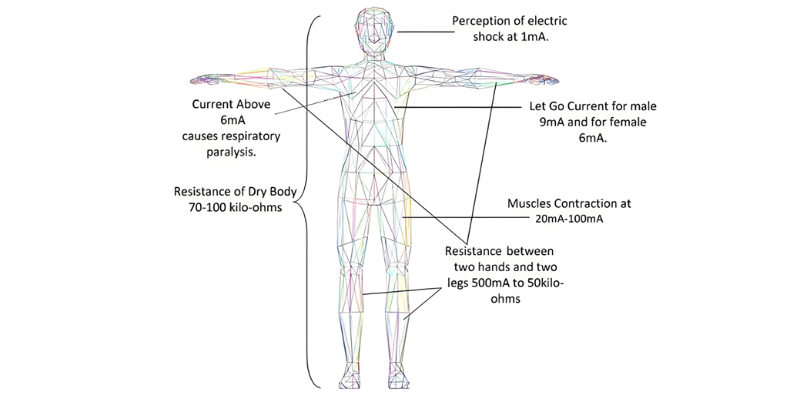When an electrical current traverses the human body, the nervous system endures an electric shock. The severity of this shock predominantly hinges on three key factors: the magnitude of the current, the pathway the current follows through the body, and the duration of contact. In the most severe instances, the shock disrupts the normal functioning of the heart and lungs, potentially leading to unconsciousness or even death.
It is generally accepted that currents below 5 milliamperes (mA) pose minimal risk. However, currents ranging from 10 to 20 mA are considered dangerous, as they can cause the victim to lose muscular control. The electrical resistance of the human body, measured between two hands or between the legs, typically spans from 500 ohms to 50,000 ohms. For example, if the human body's resistance is assumed to be 20,000 ohms, coming into contact with a 230 - volt electrical supply can be perilous. Using Ohm's Law (I = V/R), the resulting current would be 230 / 20,000 = 11.5 mA, well within the dangerous range.

The leakage current is calculated using the formula I = E / R, where E represents the supply voltage and R denotes the body resistance. The resistance of a dry body typically ranges from 70,000 to 100,000 ohms per square centimeter. However, when the human body is wet, this resistance drops dramatically, falling to between 700 and 1,000 ohms per square centimeter. This is because although the skin's inherent resistance is relatively high, external moisture significantly reduces the overall resistance.
To illustrate the impact of a wet body, consider that a 100-volt electrical supply poses as much danger to a wet body as a 1,000-volt supply does to a dry one.
Effects of Current Passing from Hand-to-Hand and Foot-to-Foot
The following describes the effects of electrical current flowing through the body from hand to hand or foot to foot:
- Perception Threshold: The sensation of an electric shock can typically be detected at a current level of around 1 milliampere (mA). At this intensity, an individual will experience a mild tingling or stimulating feeling upon contact with an electric field.
- Let Go Current: The maximum current at which a person can still release a conductor using the muscles directly affected by the current is known as the "Let Go Current." For males, this is generally considered to be 9mA, while for females, it is 6mA.
- Muscle Control Loss: When the current exceeds the Let Go Current, ranging from 20mA to 100mA, a person loses the ability to control their muscles. Currents within this range are extremely difficult to endure and can cause physical harm, although heart and respiratory functions usually remain relatively stable.
- Lethal Currents: Currents exceeding 100mA can be fatal. At this level, the heart's pumping action ceases, and the pulse disappears. Without the heart's ability to circulate oxygenated blood, brain cells begin to die rapidly due to oxygen deprivation. Additionally, at very high currents, starting from around 6 amperes and above, there is a significant risk of respiratory paralysis and severe burns.
The effects of electric shock can vary depending on whether the current is alternating current (AC) or direct current (DC). AC at common frequencies (25 - 60 cycles per second, or hertz) is generally more dangerous than DC of the same root - mean - square (RMS) value.
With the increasing prevalence of high - frequency electrical equipment, the passage of high - frequency currents through the body presents additional risks. At frequencies around 100 hertz, the typical sensation of an electric shock begins to diminish, but the potential for severe internal burns increases, making such currents equally hazardous. It is important to remember that it is the current, rather than the voltage alone, that ultimately causes fatalities.
An alternating voltage of 50 volts has the potential to generate a dangerous 50mA current. However, some individuals have survived exposure to much higher voltages due to various mitigating factors. For instance, dry skin, clean clothing, and wearing boots can significantly increase contact resistance, thereby reducing the risk of dangerous current flow through the body.